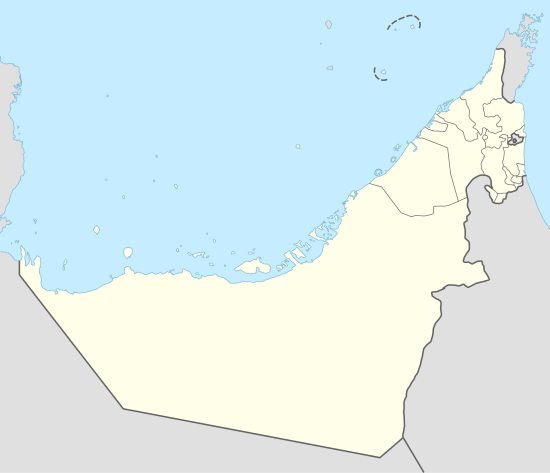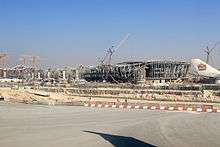Abu Dhabi International Airport
| Abu Dhabi International Airport مطار أبوظبي الدولي | |||||||||||||||
|---|---|---|---|---|---|---|---|---|---|---|---|---|---|---|---|
 | |||||||||||||||
 | |||||||||||||||
| IATA: AUH – ICAO: OMAA | |||||||||||||||
| Summary | |||||||||||||||
| Airport type | Public | ||||||||||||||
| Operator | Abu Dhabi Airports Company | ||||||||||||||
| Serves | Abu Dhabi | ||||||||||||||
| Hub for | |||||||||||||||
| Time zone | UAE Standard Time (UTC+04:00) | ||||||||||||||
| Elevation AMSL | 88 ft / 27 m | ||||||||||||||
| Coordinates | 24°25′59″N 054°39′04″E / 24.43306°N 54.65111°ECoordinates: 24°25′59″N 054°39′04″E / 24.43306°N 54.65111°E | ||||||||||||||
| Website | abudhabiairport.ae | ||||||||||||||
| Map | |||||||||||||||
 OMAA Location in the UAE | |||||||||||||||
| Runways | |||||||||||||||
| |||||||||||||||
| Statistics (2015) | |||||||||||||||
| |||||||||||||||
Abu Dhabi International Airport (Arabic: مطار أبو ظبي الدولي) (IATA: AUH, ICAO: OMAA) is an international airport in the Emirate of Abu Dhabi, the capital of the United Arab Emirates.
The airport, located 16.5 nautical miles (30.6 km; 19.0 mi) east[1] of Abu Dhabi city, is the second largest in the UAE, serving around 20 million passengers in 2014. It has three operational passenger terminals—Terminal 1 (divided into Terminals 1A and 1B), Terminal 2, Terminal 3. Abu Dhabi International Airport is spread over an area of 3,400 hectares (8,500 acres). Its terminal spaces are dominated by Etihad Airways, which is the United Arab Emirates' second largest air carrier after Emirates. More than 30 airlines offered service to over 120 destinations in more than 60 countries with non-stop services to all inhabited continents.
History
Early years
The Al Bateen Airport on Abu Dhabi Island previously served as Abu Dhabi's main airport and consisted of a single airstrip with minimal to this, smaller aircraft would land on an unsealed runway located not too far from Al Bateen, and the passengers would be processed in a tiny makeshift building. Limited flights were operated from Al Bateen and included flights to other Middle Eastern cities and Mumbai International Airport (then known as Bombay International Airport). After many years of operations, the airport was shifted to the mainland in 1982. Bateen Airport is presently used as a dedicated business jet airport.
The new airport included a circular satellite terminal (with aerobridges) with a single connection to a semi-circular terminal.[2][3] This design allowed more aircraft to park simultaneously. During the late 1990s and early 2000s, substantial work was carried out on the satellite terminal, to cater for the increase in passenger numbers, including widening the passenger waiting areas and creating extra parking spots. The main terminal also underwent some external changes, especially on the outer facade. Additionally, Terminal 2 was created to relieve the pressure of the main terminal. Terminal 2, however, does not have aerobridges and uses buses to move passengers between aircraft and the terminal. Terminal 3, was constructed over the past five years and this is mainly used by Etihad.
During the early years of operation, there were no means of getting to the airport from the cities except for private vehicle or taxis. With the creation of Abu Dhabi's bus network, city-to-airport bus services were introduced.[4]
Development since the 2000s
With the withdrawal of support for regional airline Gulf Air after nearly five decades, Etihad became the new airline to be based at the airport. It received full support from the UAE government and has come a long way since its inaugural flight in 2003. Previous Gulf Air CEO James Hogan also transferred to Etihad, bringing aviation industry knowledge and experience.
In December 2011, the government of Abu Dhabi signed a letter of intent to build a United States border preclearance facility similar to pre-clearance customs facilities in Canada, Aruba, Bermuda, the Bahamas, and Ireland.[5] Etihad operated its first flight to the U.S. from the facility January 25, 2014.[6][7][8]
In 2011, the airport was awarded 2nd Best Airport in Middle East of the Airport Service Quality Awards by Airports Council International[9][10] The airport celebrated its 30th anniversary in 2012.[11]
The new Terminal 3, a AED 1 billion (US$270 million) interim facility, was designed to allow for the airport's passenger growth before the planned opening of the new Midfield Terminal in December 2017. Used predominantly by Etihad Airways, the terminal boosted the airport's seven million passenger per year capacity to 12 million. It also added 10 new gates, two of which are Airbus A380 compatible.[12]
Facilities
Expansion


Development work has started on a new passenger terminal, the main building and centerpiece of the new airport, to be between the two runways and known as the Midfield Terminal. Upon completion in 2017, the Midfield Terminal will increase the airport’s passenger capacity to more than 30 million per year, with options for this to double in capacity to 60 million.[13] An additional facility is under consideration that would take the capacity to 80 million.
The expansion master plan projects include a third 4,100 m (13,500 ft) parallel runway, 2,000 m (6,562 ft) from the existing runways, a new 110 m (360 ft) tower between the two runways with the new Air Traffic Control centre, enhanced cargo and maintenance facilities, and other commercial developments on the land immediately adjacent to and north of the airport.
Having a total of 34 square kilometres (13 sq mi) of vast land area, the ambitious project will provide a home base for the UAE's national carrier, Etihad Airways, which will be a major user of new cargo facilities with an ultimate handling capacity of around two million tonnes of freight a year. Close to the new cargo facilities, land has been allocated for commercial activities, business parks, and property developments. Aircraft maintenance facilities will continue to be concentrated on the south side of the existing airport. The plan sets aside land for the growth of other operators such as Royal Jet and Abu Dhabi Aviation.
Among other aspects of the project, when completed, are the design of remote aircraft stands complete with airfield ground lighting and hydrant fuel.
The general exterior of the terminal was designed by international architecture firm Kohn Pedersen Fox Associates.
City terminal
A check-in facility exists in downtown Abu Dhabi, for travelers who want to check in before they fly. This facility, known as the City Terminal, resembles an airport and has lounge and transport facilities. After having checked-in at the City Terminal, travelers can arrive at the airport just one hour before the departure of their flight. A further check in facility is operated by Etihad Airways at the Etihad Travel Mall on the outskirts of Dubai.[14]
Runways
Abu Dhabi International Airport has two parallel runways, 13R/31L and 13L/31R. Both are 4,100 m × 60 m (13,450 ft × 200 ft).[15]
Airlines and destinations
Passenger
The following airlines operate regular scheduled and charter flights to and from Abu Dhabi:[16]
- Notes
- ^1 Biman Bangladesh Airlines' flight from Abu Dhabi to Dhaka makes a stop at Sylhet. However, the flight from Dhaka to Abu Dhabi is non-stop.
Cargo
Ground transportation
Etihad Airways provides a luxury coach service from Abu Dhabi International Airport to Al Ain International Airport and Dubai Travel Mall for their customers.[29]
The Department of Transport provides buses throughout the emirate of Abu Dhabi[30] include:
- A1 - Abu Dhabi International Airport to City Air Terminal (near Abu Dhabi Mall, via Abu Dhabi Bus Station)
- X81 - Abu Dhabi International Airport to Ruwais ADNOC (Western Region, via Mussafah and Tarif)
- 162 - Abu Dhabi International Airport to Khalifa Street Abu Dhabi (near Corniche, via Abu Dhabi Bus Station)
- 211 - Al Rahba to Dalma Mall (via Abu Dhabi International Airport)
- 240 - Al Rahba to Al Mafraq Workers City (via Abu Dhabi International Airport)
- 170 - Abu Dhabi International Airport to Zayed Sports City (near Sheikh Zayed Grand Mosque, however goes via Yas Island, Yas Mall, Saadiyat Island and Abu Dhabi Bus Station)
- 490 - Abu Dhabi International Airport to Al Ain Bus Station (via Baniyas Court)
Accidents and incidents
On 19 April 2007, a Qatar Airways Airbus A300B4-622R caught fire while maintenece at an airport hangar. There were no fatalities but the aircraft was destroyed and was written off.
References
- ↑ "Google Maps". Google Maps. Retrieved 1 June 2015.
- ↑ "History - About Us - Al Bateen Executive Airport". Archived from the original on 21 April 2014. Retrieved 1 June 2015.
- ↑ "Photos: Airbus A330-223 Aircraft Pictures - Airliners.net". Retrieved 1 June 2015.
- ↑ "Bus Transportation". Retrieved 1 June 2015.
- ↑ "U.S. Security Expands Presence at Foreign Airports". New York Times. Retrieved 2013-05-19.
- ↑ "US pilots slam Abu Dhabi airport facility move". Trade Arabia. Retrieved 2014-01-25.
- ↑ Caline Malek (January 25, 2014). "First flight departs to US using Customs checkpoint in Abu Dhabi". The National. Retrieved January 27, 2014.
- ↑ The Abu Dhabi Pre-clearance Facility: Implications for U.S. Businesses and National Security: Hearing before the Subcommittee on Terrorism, Nonproliferation, and Trade of the Committee on Foreign Affairs, House of Representatives, One Hundred Thirteenth Congress, First Session, July 10, 2013
- 1 2 http://www.starairaviation.net/air_cargo.htm[]
- ↑ "ASQ Award for Best Airport in Middle East" Airports Council International. 14 February 2012. Retrieved 2012-04-13
- ↑ "Three decades of success". ABUDHABI AIRPORT. Retrieved 1 June 2015.
- ↑ "Abu Dhabi International Airport". Abu Dhabi International Airport. 2009. Retrieved 2009-09-29.
- ↑ "Midfield Terminal Complex Development". ABUDHABI AIRPORT. Retrieved 1 June 2015.
- ↑ Bibbo', Barbara (2004-07-28). "Easy check-in facilities draw air travellers to city terminal". gulfnews.com. Gulf News. Retrieved 2014-10-01.
- ↑ United Arab Emirates AIP Archived December 30, 2013, at the Wayback Machine. (login required)
- ↑ abudhabiairport.ae - Our Destinations retrieved 24 August 2016
- ↑ "Etihad Airways reduces Minsk service from Jan 2017". Airlineroute. Retrieved 22 November 2016.
- ↑ "Etihad Airways closes Sao Paulo reservations from late March 2017". Airlineroute. Retrieved 15 November 2016.
- 1 2 http://www.routesonline.com/news/38/airlineroute/269834/jet-airways-ends-2-india-abu-dhabi-routes-in-jan-2017/
- ↑ "Press Release". Jet Airways. Retrieved 28 October 2016.
- ↑ "KLM S17 Middle East Service Changes". Airlineroute. Retrieved 24 November 2016.
- 1 2 http://blog.virginaustralia.com/news-and-updates/melbourne-los-angeles-and-perth-abu-dhabi-flights
- ↑ DHL and Etihad Cargo increase connectivity through the Middle East Archived November 5, 2014, at the Wayback Machine.
- ↑ WAM. "Etihad Cargo to partner with Avianca Cargo on new freighter service". Retrieved 1 June 2015.
- ↑ Justin Burns (12 January 2016). "Atlas". AIR CARGO WEEK.
- ↑ "Etihad Airways Cargo Timetable".
- 1 2 Etihad Cargo schedule
- ↑ "Singapore Airlines Cargo W14 Operations". Retrieved 1 June 2015.
- ↑ "Dubai. Retrieved on 6 February 2009.
- ↑ "To and from the airport - Abu Dhabi International Airport". ABUDHABI AIRPORT. Retrieved 1 June 2015.